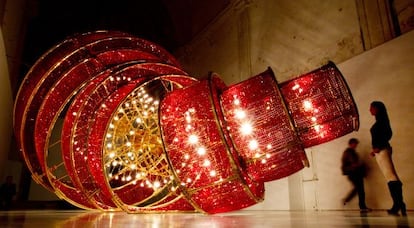Seeds of change
The world-famous Ai Weiwei's work arrives in Seville

Five tons of the 100 million porcelain sunflower seeds with which Ai Weiwei covered the floor of the Tate Modern's Turbine Hall welcome you to his new retrospective at Seville's Andalusian Center of Contemporary Art (CAAC), the first devoted to the notorious Chinese artist to be held in Spain.
As famous for his influence on the art world as for his fierce opposition to the Chinese regime, Ai employed 1,600 artisans to handpaint 150 tons of the fake seeds for the original 2010 installation, which he later divided into separate batches for sale. The portion now in Andalusia -- 3.3 million seeds -- has to be viewed surrounded by the security measures imposed by the lender: they are cornered off by a barrier and an alarm sounds if anyone succumbs to the temptation of carrying away a souvenir.
Ai might well have wished otherwise, but he was unable to supervise preparations for Resistencia y tradición (Resistance and tradition) or attend the show's opening last week as he is prohibited from leaving China, where he faces tax evasion and pornography charges and was jailed for a spell in 2011.
On paper, Sunflower Seeds may be the biggest draw, but it has a serious competitor in the spectacular Descending Light (2007), an enormous Maoist red lamp that occupies the central space of the center. A metaphor of the decadence of the Chinese communist regime, the piece has only been on display once before, in New York when it was created for the Mary Boone Gallery, and is now owned by Helga de Alvear. The Spanish collector has lent other pieces for the show, including 268 Fake, which carries the same name as Ai's Beijing studio and features images of his everyday life taken for his blog while the Chinese government allowed (2005-2009), and Colored Vases (2008), a collection of Neolithic pots defaced with industrial paint, meant as a reflection on the destruction of China's cultural heritage.
Ivorypress, where he exhibited in 2009, has also lent Ai's famous 1995 photo triptych showing the artist dropping a purportedly priceless Han dynasty urn.
Ai Weiwei. Resistencia y tradición. Until June 23 at Centro Andaluz de Arte Contemporáneo, Monasterio de la Cartuja de Santa María de Las Cuevas, Seville. www.caac.es
Tu suscripción se está usando en otro dispositivo
¿Quieres añadir otro usuario a tu suscripción?
Si continúas leyendo en este dispositivo, no se podrá leer en el otro.
FlechaTu suscripción se está usando en otro dispositivo y solo puedes acceder a EL PAÍS desde un dispositivo a la vez.
Si quieres compartir tu cuenta, cambia tu suscripción a la modalidad Premium, así podrás añadir otro usuario. Cada uno accederá con su propia cuenta de email, lo que os permitirá personalizar vuestra experiencia en EL PAÍS.
¿Tienes una suscripción de empresa? Accede aquí para contratar más cuentas.
En el caso de no saber quién está usando tu cuenta, te recomendamos cambiar tu contraseña aquí.
Si decides continuar compartiendo tu cuenta, este mensaje se mostrará en tu dispositivo y en el de la otra persona que está usando tu cuenta de forma indefinida, afectando a tu experiencia de lectura. Puedes consultar aquí los términos y condiciones de la suscripción digital.
Últimas noticias
Most viewed
- Why we lost the habit of sleeping in two segments and how that changed our sense of time
- Trump’s obsession with putting his name on everything is unprecedented in the United States
- Pablo Escobar’s hippos: A serious environmental problem, 40 years on
- The Florida Keys tourist paradise is besieged by immigration agents: ‘We’ve never seen anything like this’
- Charles Dubouloz, mountaineering star, retires at 36 with a farewell tour inspired by Walter Bonatti








































